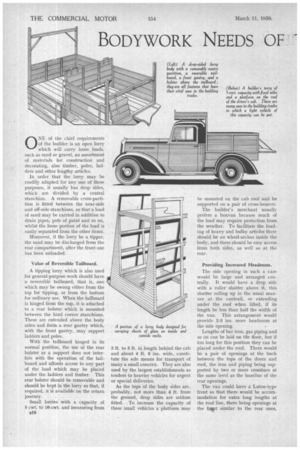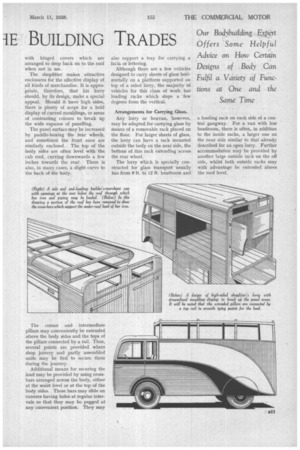BODYWORK NEEDS OF "
Page 44

Page 45

If you've noticed an error in this article please click here to report it so we can fix it.
-IE BUILDING TRADESers ONE of the chief requirements of the builder is an open lorry which will carry loose loads, such as sand or gravel, an assortment of materials for construction and decorating, also timber, poles, ladders and other lengthy articles.
In order that the lorry may be readily adapted for any one of these purposes, it usually has drop sides, which are divided by a central stanchion. A removable cross-partition is fitted between the near-side and off-side stanchions, so that a load of sand may be carried in addition to drain pipes, pots of paint and so on, whilst the loose portion of the load is easily separated from the other items.
Moreover, if the lorry be a tipper, the sand may be discharged from the rear compartment, after the front one has been unloaded.
Value of Reversible Tailboard.
A tipping lorry which is also used for general-purpose work should have a reversible tailboard, that is, one which may be swung either from the top for tipping, or from the bottom for ordinary use. When the tailboard is hinged from the top, it is attached to a rear bolster which is mounted between the hind corner stanchions. These are extended above the body sides and form a rear gantry which, with the front gantry, may support ladders and poles.
With the tailboard hinged in its normal position, the uSe of the rear bolster as a support does not interfere with the operation of the tailboard and affords access to any part of the load which may be placed under the ladders and timber. This rear bolster should be removable and should be kept in the lorry so that, if required, it is available on the return journey.
Small lorries with a capacity of 5 cwt. to 10 cwt. and measuring from slO 3 ft. to 5 ft. in length behind the cab and about 4 ft. 6 ins, wide, constitute the sole means for transport of many a small concern. They are also used by the largest establishments as tenders to heavier vehicles for urgent or special deliveries.
As the tops of the body sides are. probably, not more than 4 ft, from the ground, drop sides are seldom fitted. To increase the capacity of these Small vehicles a platform may be mounted on the cab roof and be supported on a pair of cross-bearers.
The builder's merchant usually prefers a boxvan because much of the load may require protection from. the weather. To facilitate the loading of heavy and bulky articles there should be no wheel-arches inside the body, and there should be easy access from both sides, as well as at the rear.
Providing Increased Headroom.
The side opening in such a case would be large and arranged centrally. It would have a drop side with a roller shutter above it, this shutter rolling up in the usual manner at the cantrail, or extending under the roof when lifted, if its length be less than half the width of the van. This arrangement would provide 2-3 ins, more headroom at the side opening.
Lengths of bar iron, gas piping and so on can be laid on the floor, but if too long for this position they can be placed under the roof. There would be a pair of openings at the back between the tops of the doors and roof, the iron and piping being supported by two or more crossbars at the same level as the baseline of the rear openings.
The van could have a Luton-type front so that there would be accommodation for extra long lengths at the roof line, there being openings at the frowt similar to the rear ones. with hinged covers which are arranged to drop back on to the roof when not in use.
The shopfitter makes attractive enclosures for the effective display of all kinds of merchandise. It is apprapriate, therefore, that his lorry should, by its design, make a special appeal. Should it have high sides, there is plenty of scope for a bold display of curved mouldings, or areas of contrasting colours to break up the wide expanse of panelling.
The panel surface may be increased by paddle-boxing the rear wheels, and sometimes the front ones are similarly enclosed. The top of the body sides are often level with the cab roof, curving downwards a few inches towards the rear. There is also, in many cases, a slight curve to the back of the bOdy.
The corner and intermediate pillars may conveniently be extended above the body sides and the tops of the pillars connected by a rail. Thus, several points are provided where shop joinery and partly assembled units may be tied to sectire them during the journey.
Additional means for securing the load may be provided by using crossbars arranged across the body, either at the waist level or at the top of the body sides. These bars may slide on runners having holes at regular intervals so that they may be pegged at any convenient position. They may also support a tray for carrying a facia or lettering.
Although there are a few vehicles designed to carry sheets of glass horizontally on a platform supported on top of a sided lorry, the majority of vehicles for this class of work has loading racks which slope a ' few degrees from the vertical.
Arrangements for Carrying Glass.
Any lorry or boxvan, however, may be adapted for carrying glass by means of a removable rack placed on the floor. For larger sheets of glass, the lorry can have a rack mounted outside the body on the near side, the bottom of this rack extending across the rear wheel.
The lorry which is specially constructed for glass transport usually has from 9 ft. to 12 ft. headroom and a loading rack on each side of a central gangway. For a van with less headroom, there is often, in addition to the inside racks, a larger one on the near side similar to that already described for an open lorry. Further accommodation may be provided by another large outside rack on the off side, whilst both outside racks may with advantage be extended above the roof leVel.
















































































